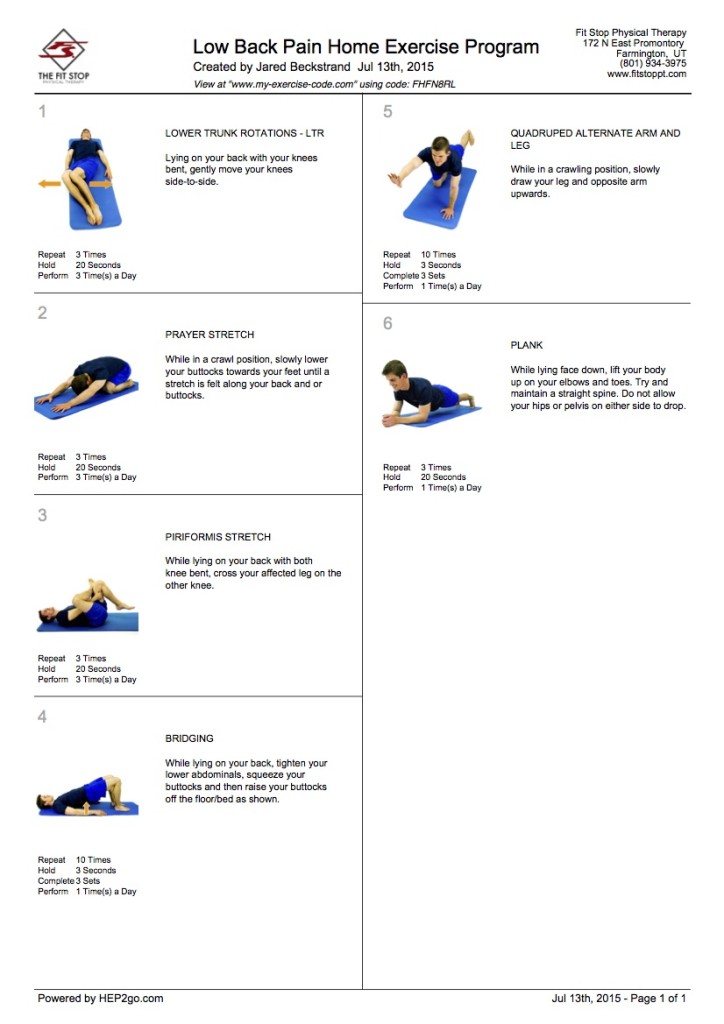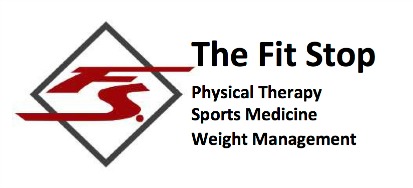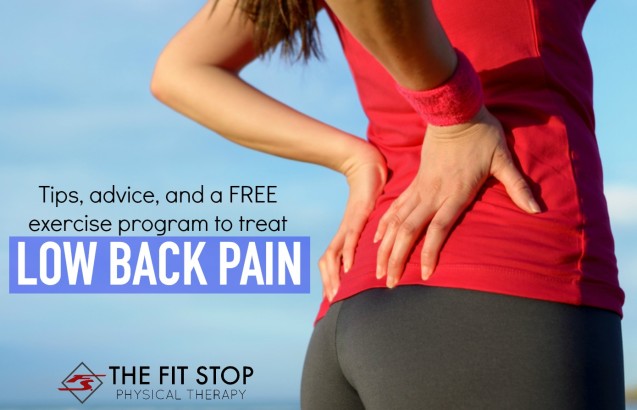By fitstoppt 13 Jul, 2015 Advice, At Home, Back Pain, FAQ, Fitness, Injury, Low Back Pain, Physical Therapy at home, back, best, cost effective, exercise, inexpensive, low back, pain, program, treatment 
We’ve all been there before. It may have been after a long run or a heavy workout. Maybe you helped your friend move into a new home or had a long day of work in the yard. You may have even just slept wrong and now it’s there. Back pain. This is, without a doubt, the most common problem we encounter in outpatient physical therapy. In fact, 9 out of 10 people will experience back pain at some point in their lives. From weekend warriors to years of chronic, nagging pain, if you’re a living, breathing, human being, you will one day experience back pain (if you haven’t experienced it you know someone who has and, I’m sorry to say, chances are that you will in the future!). So why do we get back pain? And more importantly, what are some things we can do about it? Jared Beckstrand, PT, DPT, shares some tips, advice, and even a free home exercise program to help you feel better.
What it is?: Important note: not all back pain is created equally!!! That being said, not all treatment for low back pain is the same. The key to successful treatment of low back pain is coming to an accurate diagnosis as to the actual cause of the pain. For the purposes of this blog post, I have decided to focus my remarks around “mechanical low back pain”. No numbness or tingling, no sciatica, no significant movement impairments (if you’re experiencing these issues please consult a medical professional; see disclaimer below)… this is just the good ol’ “my back gets sore, tired, and achy consistently” low back pain. You may have noticed it after playing sports or a long day in the yard. This pain is primarily “soft tissue” in nature, meaning it’s a problem with the muscles, tendons, or ligaments that hold your spine together. These areas are susceptible to stresses placed on them and react accordingly. A certain amount of stress is good and needed for them to stay healthy and functional; it’s when this stress becomes excessive that pain starts to show up.
Why do we get it?: Again- it’s this idea of excessive stress on soft tissue. The most common types of injury I see are over-exertion, poor posture/sitting (also known as “desk-job-itis”), and core weakness. Over-exertion is self-explanatory; this is the pain you feel the next day after helping your buddy move or after a particularly tough day in the gym. Your muscles were overworked and now they’re letting you know about it. Poor posture (especially in sitting) can result in stretched muscles/tendons/ligaments that, when held too long in that posture, can cause excessive strain on these structures resulting in pain. Finally, and dare I say one of the most typical, is the back pain directly related to core weakness. A strong midsection is vital to spine stabilization. One problem I see a lot in people is that they neglect their core. For example people who workout tend to do a lot of bench press, squats, lunges, arms, etc, but neglect the stomach, sides, and back (the whole “core of our movement”). Neglecting strengthening this area can lead to weakness; and we all know what happens to the weakest link in a chain – it’s the first one to break!
So what do we do about it?: Oftentimes people will ask us about heat vs ice on an injury. As a general rule with back pain – if it is an acute exacerbation (less than 7 days) it should respond well to anti-inflammatory measures including medicine [Ibuprofen/Acetaminophen (use as directed)], rest, and ice. Anything you can do to decrease the inflammatory response. If it’s more of a dull, achy, constant pain that “stiffens up” throughout the day your best bet is most likely heat. This will open up capillaries in the area, increase blood flow, and ultimately produce muscle relaxation.
What about stretching and exercises? They’re crucial! As mentioned previously, most back pain is accompanied by tight muscles – your muscles in your lower back go into spasm around the injured area to prevent further motion that could be damaging. This tightness in the back is the first issue we need to overcome. We’ll then follow that up with a few strengthening exercises to specific, key muscles to stabilize and strengthen the spine to withstand the stresses that are placed on it.
Below you will find a PDF copy of a very general “low back pain” home exercise sheet. This is similar to what I use in my clinic and was generated on an amazing website, www.HEP2go.com. Click the picture below to open this free download in another window.

There you have it! A very general and brief overview of mechanical low back pain and some insight as to what you can do to potentially alleviate general back pain. Once again, the very best thing you can do is consult with a medical professional about the best plan to help out your specific type of back pain (treatments can vary greatly depending on the specific nature of your pain). Of course should you have any questions about your back or other problem please feel free to contact us in one of our clinics closest to you! Click this link for our contact information.
Disclaimer: The information presented in this post is designed to be used for informational purposes only. The diagnoses and treatment plans outlined are extremely generalized and may or may not be the recommended interventions for your specific problem. If you are experiencing pain, you are encouraged to consult a healthcare provider to determine the best treatment plan that will be in your individual best interest. Fit Stop Physical Therapy claims exemption from accident, injury, or perpetuation of any injury incurred while performing exercises found on this website. The user assumes all risk… and reward!!
Jared Beckstrand, PT, DPT
Fit Stop Physical Therapy – Farmington
172 N East Promontory Ste 200
Farmington, UT 84025
(801) 558-8612



